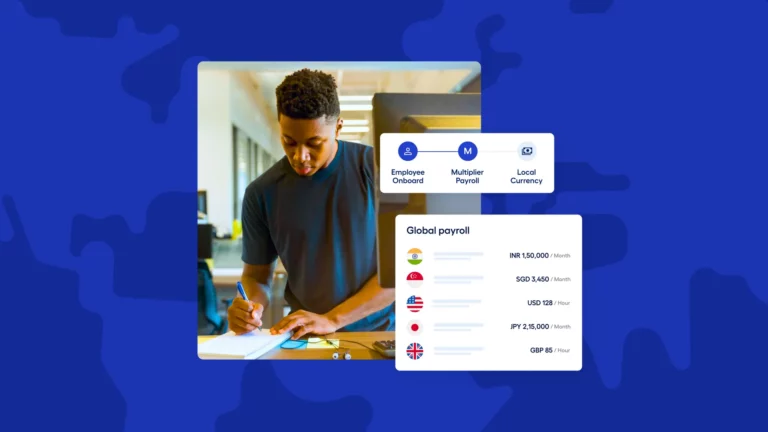The past few years have created a whole new community of entrepreneurs. These entrepreneurs live digitally, own a laptop, and are equipped to work from anywhere. In short, they live a nomadic (read mobile) lifestyle. A digital nomads choose to work at unconventional locations like cafes, beaches, or hotel rooms, as they are not tied to any geographic location.
Often known as digital nomads, these entrepreneurs rely on technology to work remotely from different locations. However, you need legal rights to work in various countries, which requires understanding the process thoroughly.
Today’s blog post is all about digital nomad visa – what it is, how it works, the application process, countries offering digital nomad visas, and more.
Let’s get started!
What is a Digital Nomad Visa?
A digital nomad visa is a document that provides an individual the legal right to work remotely while staying away from their home country or country of permanent residence.
Digital nomad visas can also be defined as programs issued by the government. Several regions like, Cayman Islands have given unique names like Global Citizen Concierge Programgive these to such programs unique names, like, Cayman Islands’ Global Citizen Concierge Program. In a few regions, it is also known by a general term like residence permit.
Other than employees, students can also use digital nomad visas. However, the expenses and requirements may vary.
Is Visa a Must to be a Digital Nomad?
No, remote employees do not need a visa to be a digital nomad. An individual requires a digital nomad work visa when they want to stay longer in a country than the duration permitted by a tourist visa.
When an individual needs a digital nomad visa, they must meet the visa requirements that vary by country. However, none of the digital nomad visas or tourist visas allow the holders to get employed by a local company in the country.
How do Digital Nomad Visas work?
Policies and regulations for digital nomad visas vary from country to country. A few countries allow eligible citizens to apply for digital nomad work visas online. On the other hand, a few others need petitioners to submit visa applications via an embassy or consulate.
Remote employees must check the application procedure and requirements for a digital nomad visa. They can ask for information on digital nomad visa workings and assistance from diplomatic missions.
Generally, remote employees need;
- Proof of steady remote income; and
- An eligible and valid passport; for a digital nomad visa application.
Several countries also require applicants to pay a visa application fee. Remote employees must ensure checking the visa requirements of their destination country as they may need support documentation like medical insurance, vaccine certificates, etc.
Also, even though the applicants have sufficient documentation, a few other factors determine the applicant’s eligibilitythere are a few other factors that determine the eligibility of the applicant.
- Nationality
- Visa history
- Whether or not the applicant is considered a threat to the destination country’s security or health
Hence, remote employees must stay updated on the information regarding digital nomad visa eligibility criteria.
Step-by-Step Application Process for Digital Nomad Visa
To apply for a digital nomad visa, applicants must follow the provided instructions;
Step 1- Fill out the application form
The first step to getting a digital nomad visa is filling out the application form. Some countries have the online facility of form fill-up, while others require applicants to fill out the form physically. Applicants must ensure to provide all accurate and up-to-date details.
Step 2- Book an appointment with the embassy or consulate
The next step involves finding a visa office, a consulate, or an embassy. Applicants may have to apply at a neighboring embassy depending on the residence country.
However, once the applicant has discovered a visa office, they need to set an appointment to submit the application and attend the interview.
Step 3- Prepare the required documents
Once the application form is ready, an applicant must prepare the documents required in the process. One may have to translate documents or get them certified with an apostille stamp in a few cases.
Generally, the documents required for a digital nomad visa are;
- Visa application form
- Passport
- Identify photos
- Proof of financial income (revenue source, amount, etc.)
- Travel health insurance
- Civil documents like CV, qualifications, birth certificate, etc.
- Remote work evidence (work contract, business license, client details, etc.)
Step 5- Submit the application
The final step in the digital nomad visa application process is submitting the form. Once the form and the documents are ready, one must submit them to the embassy or consulate. Further, the applicant must attend the visa interview and pay the fee.
Note: Some countries require the applicants to pay the visa application fee beforehand. They must then submit the payment receipt and the other application documents.
Work Authorization via Digital Nomad Visa Program
A digital nomad visa caters to the needs of employers and employees in an ever-changing future work environment provides legal authorization to work in a foreign country. It caters to the needs of employers and employees in an ever-changing future work environment.
In other words, a digital nomad work visa opens an immigration pathway for individuals to move freely beyond borders while carrying their living-earning work with them.
Several digital nomads travel to different countries while spending shorter periods in their host country. These individuals often use tourist visas or visa waiver programs to travel. However, tourist visas or visitor visas do not permit remote work.
That being said, it is also true that once digital nomads reach their destination country, no authorities track their activities. They do not barge into spaces of remote work like cafés or bookstores.
But the rising number of digital nomads may cause more border checkpoints to become more informed. Further, customs officials may question visitor activities to determine if anybody is breaching the tourist visa terms.
Therefore, if digital nomads are sure about prolonged remote working from the destination country, they must inquire about digital nomad work visas.
Digital nomad visas allow individuals to work legally abroad. They can capitalize on temporary resident benefits, ensuring a stress-free remote work experience.
25 Countries Offering Digital Nomad Visas
As of July 2021, there were 24 regions providing programs for temporary remote employees. Here’s a list of the countries that offer digital nomad visas.
Costa Rica
The temporary residence visa offers two-year of remote work opportunities. Applicants must meet a monthly income of $2,500. Or they can make a $60,000 deposit at any local bank. If there are more dependents, the amount increases.
Croatia
Croatia’s digital nomad visa lasts up to one year. Applicants can file a new application within six months. They must prove a monthly income of 16,907.50 kunas (HRK) or $2,671.14 or a yearly income of 202,890 HRK ($32,053.65). The income requirement amount increases by 10% per family member. Depending on the application method, the application fee is 420 HRK to 880 HRK.
Estonia
In August 2020, Estonia launched its official digital nomad visa, and it remains valid for a year. Applicants must prove a minimum income of €3,504 and pay a state fee of €80 (for a short-term stay Type C visa) or €100 (for a long-stay Type D) visa.
Germany
The residence permit for digital nomads in Germany allows freelancers and self-employed people to stay for three months. However, the time can be extended up to three years. The visa application fee costs €60.
Mexico
The temporary resident visa of Mexico is targeted toward Canadians but not restricted to them. Digital nomads can work remotely within Mexico for 180 days to four years. Applicants must earn CAD 2,720 ($2,166.11) per month or have a monthly bank balance of CAD 45,334 ($36,102.41) during the last 12 months. The application fee is $56. But it can increase if one needs additional services.
Norway
The visa in Norway gives remote workers two years of residency within the country. It costs €600, and the applicant’s annual income must be at least €35,719.
Portugal
The digital nomad visa is valid for a year in Portugal. It can be renewed twice for two years each time. The visa costs €83 plus a resident permit fee of €72.
Czech Republic
Zivno – the Czech Republic’s freelancer visa program lasts for a year and requires a variable application fee. The applicants need to produce proof of 124,500 korun (CZK) or $5,750.58 as minimum income, passport, criminal record, accommodation proof, etc.
Iceland
The long-term visa for remote employees is available to the digital nomads from any country that does not require a visa to travel to Iceland. It is unavailable for any part of the European Union (EU). The visa can be issued for 180 days. The applicant must submit the visa application and a fee of 12,200 ISK ($98.64) per person.
Hungary
Known as the White Card, Hungary offers a digital nomad visa for a year, and it can be extended for another year. The previous six months’ income to prove is €2,000 per month, and the application fee is €110 per applicant.
The Bahamas
The Bahamas Extended Access Travel Stay (BEATS) program is valid for 12 months but can be extended to 3 years. It costs a $25 application fee plus $1000 for the first applicant and $500 for each dependent.
Barbados
The digital nomad program in Barbados is called the Barbados Welcome Stamp. The program costs $2000 per individual or $3000 for a couple/family. It is valid for one year and the annual income to prove is $50,000.
Bermuda
The Work from Bermuda visa program, lasts for one year and the cost of the visa program is $263. However, there is no minimum income to prove. The applicant must earn enough to support a very high living (Bermuda is one of the most expensive countries considering the cost of living).
The Cayman Islands
The Cayman Islands Global Citizen Concierge Program is mostly for wealthy remote workers. The cost of the program is $1,469. It is valid for two years and the annual income to prove is $100,000 for a single, $150,000 for a couple, and $180,000 for a family.
Dominica
Dominica has one of the cheapest digital nomad visa options. The visa remains valid for 18 months, and the cost of application is $100 along with $800 single person and $1200 for a family. The applicant must prove an annual income of $70000.
Brazil
The digital nomad visa in the country remains valid for one year and can be renewed for another year. The income to prove is $1500 per month.
Dubai
The country launched its one-year virtual work visa that costs $287. The income to prove is €5,000 per month (over the last three months). Also, the applicant needs to show proof of employment or company ownership.
Taiwan
The Gold Card program of Taiwan offers open work permits with no validity as such. It costs $100 to $310 depending on nationality and period of stay. The income to prove is $5,700 per month, but applicants can also enter the country based on skills.
Monserrat
The Monserrat Remote Work Stamp program costs $500 for a single person, $750 for a family (up to 3 dependents), and $250 for each additional family member. The income to prove is $70000 a year.
Malta
The Nomad residency permit is targeted toward the non-EU remote employees. It remains valid for a year and can be renewed. The visa costs €300, including family, and the applicant must prove a monthly income of €2700 and a rental contract or property purchase.
Greece
The country offers two visa programs – the first is a 50% income tax reduction for seven years to specific nationalities committing to stay in Greece for at least two years. The second program is a digital nomad visa program for non-EU/EEA citizens. It lasts up to one year and can be extended up to two years. The visa cost is €75, and the income requirement is €3,500 per month add, 20% for spouse/partner and 15% for each child.
Romania
Romania offers a 12-month digital nomad visa that can be extended to another 12 months. The income to prove is €3,300 per month.
Spain
Spain offers non-lucrative visa that allows remote workers to stay for 12 months. The visa can be renewed for another 24 months. The applicant needs to prove a monthly income of €2151, and the application costs $140.
Digital Nomad Visa vs. Tourist Visa – What are the Differences?
The key differences between a digital nomad visa and a tourist visa are:
| Digital nomad visa | Tourist visa |
| It takes a few months to process a digital nomad visa. | Gets processed within a couple of weeks |
| It is issued for more than 90 days | It is generally valid for 30 days |
| It permits individuals to work and travel | It allows traveling only |
| Individuals applying for digital nomad visas must be employed. | No employment is required. |
Digital Nomad Visa Denial – What are the Reasons?
Here are a few reasons why a digital nomad visa may be denied;
- Convicted of criminal activities or serious crime like drug smuggling, human trafficking, etc.
- The applicant’s job cannot be performed remotely (like, on-site construction employees, hospital employees, etc.)
- False information provided in the visa application form
- The applicant’s income does not meet the yearly income requirement
Managing Digital Nomads Made Easy with Multiplier
The count of digital nomads across countries is on the rise. Hence, organizations are embracing this new community of employees.
As employers, if you plan to hire digital nomads, we suggest taking professional assistance because managing digital nomads can be critical. There’s a lot to take care of, like, setting up teams, handling payrolls, and managing digital nomad taxes.
But with platforms like Multiplier, your work can get easier. Partnering with Multiplier can help you with everything related to digital nomads.
Its EOR/ PEO solution handles multi-currency payment, payroll, taxation, and legal compliance, country-specific benefits and compensation, etc.
Thus, you can be stress-free about managing your digital nomads and focus on the strategic aspects of the business.
FAQs
Q. How Much Time Does It Take to Get a Digital Nomad Visa?
The processing time of a digital nomad visa differs from country to country. However, the processing takes at least one month. It may be longer in a few countries.
Q. What is the Cost of a Digital Nomad Visa?
The application fee for digital nomad visas varies by country. On average, it can cost within $200 to $2000. A few countries like Barbados, Barbuda, and Antigua have the highest visa application fees, and it can cost up to $3000 for family applications.







